Liverpool Cathedral is the Church of England cathedral of the Diocese of Liverpool, built on St James's Mount in Liverpool and is the seat of the Bishop of Liverpool. Its official name is the Cathedral Church of Christ in Liverpool but it is dedicated to Christ and the Blessed Virgin. The total external length of the building, including the Lady Chapel, is 189 metres (620 ft) making it the second longest cathedral in the world; its internal length is 146 metres (479 ft). In terms of overall volume, Liverpool Cathedral ranks as the fifth-largest cathedral in the world and contests the title of largest Anglican church building alongside the incomplete Cathedral of Saint John the Divine in New York City. With a height of 100.8 metres (331 ft) it is also one of the world's tallest non-spired church buildings and the third-tallest structure in the city of Liverpool.
The Anglican cathedral is one of two in the city. The other, the Roman Catholic Metropolitan Cathedral of Liverpool, is situated approximately half a mile to the north. The cathedrals are linked by Hope Street, which takes its name from William Hope, a local merchant whose house stood on the site now occupied by the Philharmonic Hall, and was named long before either cathedral was built.
John Charles Ryle was installed as the first Bishop of Liverpool in 1880, but the new diocese had no cathedral, merely a "pro-cathedral", the parish church of St Peter's, Church Street. St Peter's was unsatisfactory; it was too small for major church events, and moreover was, in the words of the Rector of Liverpool, "ugly & hideous". In 1885 an Act of Parliament authorised the building of a cathedral on the site of the existing St John's Church, adjacent to St George's Hall. A competition was held for the design, and won by Sir William Emerson. The site proved unsuitable for the erection of a building on the scale proposed, and the scheme was abandoned.
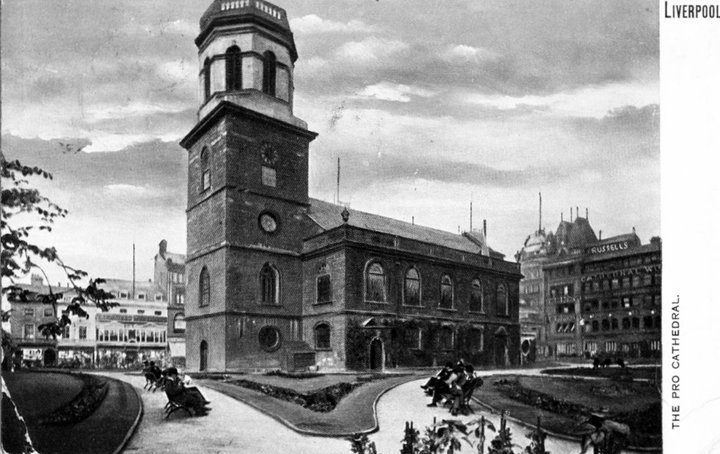
In 1900 Francis Chavasse succeeded Ryle as bishop, and immediately revived the project to build a cathedral. There was some opposition from among members of Chavasse's diocesan clergy, who maintained that there was no need for an expensive new cathedral. The architectural historian John Thomas argues that this reflected "a measure of factional strife between Liverpool Anglicanism's very Evangelical or Low Church tradition, and other forces detectable within the religious complexion of the new diocese." Chavasse, though himself an Evangelical, regarded the building of a great church as "a visible witness to God in the midst of a great city".
He pressed ahead, and appointed a committee under Sir William Forwood to consider all possible sites. The St John's site being ruled out, Forwood's committee identified four locations: St Peter's and St Luke's, which were, like St John's, found to be too restricted; a triangular site at the junction of London Road and Monument Place; and St James's Mount. There was considerable debate about the competing merits of the two possible sites, and Forwood's committee was inclined to favour the London Road triangle. However, the cost of acquiring it was too great, and the St James's Mount site was recommended. A historian of the cathedral, Vere Cotton, wrote in 1964:
"Looking back after an interval of sixty years, it is difficult to realise that any other decision was even possible. With the exception of Durham, no English cathedral is so well placed to be seen to advantage both from a distance and from its immediate vicinity. That such a site, convenient to yet withdrawn from the centre of the city … dominating the city and clearly visible from the river, should have been available is not the least of the many strokes of good fortune which have marked the history of the Cathedral".
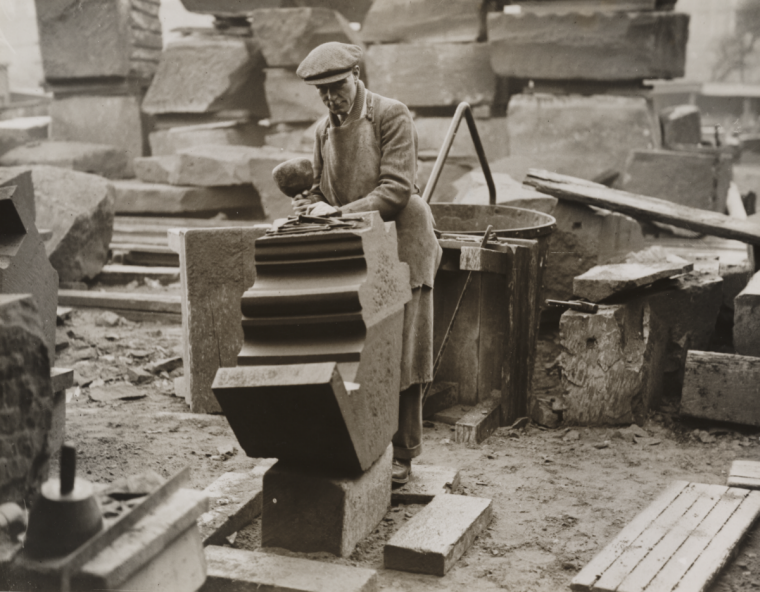
A stonemason at work on the Cathedral
Fund-raising began, and new enabling legislation was passed by Parliament. The Liverpool Cathedral Act 1902 authorised the purchase of the site and the building of a cathedral, with the proviso that as soon as any part of it opened for public worship, St Peter's Church should be demolished and its site sold to provide the endowment of the new cathedral's chapter. St Peter's place as parish church of Liverpool would be taken by the existing church of St Nicholas near the Pier Head.
The cathedral was built mainly of local sandstone quarried from the South Liverpool suburb of Woolton. The last sections (The Well of the Cathedral at the west end in the 1960s and 1970s) used the closest matching sandstone that could be found from other North West quarries once the supply from Woolton had been exhausted.
The Belltower
The belltower is the largest, and also one of the tallest, in the world. It houses the world's highest (67 m (220 ft)) and heaviest (31 UK tons; 31.5 tonnes) ringing peal of bells.

The Great George Bell being transported to the Anglican Cathedral up St. James Road in 1951.
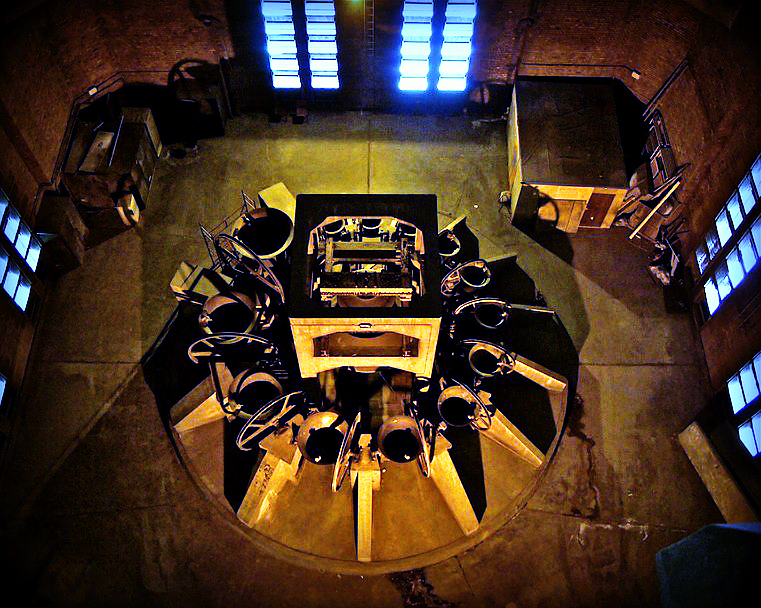
The Bell Tower
The Organ
The organ, built by Henry Willis & Sons, is the largest pipe organ in the UK with two five-manual consoles, 10,268 pipes and a trompette militaire. There is an annual anniversary recital on the Saturday nearest to 18 October, the date of the organ's consecration. There is a two-manual Willis organ in the Lady Chapel.
Organists and directors of music
1910 – Frederick William Burstall
1915–1955 – Walter Henry Goss-Custard
1931–1982 – Ronald Woan (director of music)
1955–1980 – Noel Rawsthorne
1980 – Ian Tracey (later organist titulaire)
2008 – David Poulter (director of music)
In 1989, a generous benefactor, who attended a number of recitals each year, enabled a full-scale five-manual, mobile, central space console to be provided: in future, recitalists could be seen as well as heard! The work was carried out by David Wells, who has charge of the organ.
Stained glass
The firm of Powell & Sons (Whitefriars), Ltd., of London, provided most of the stained glass designs. John William Brown (1842–1928) designed the Te Deum window in the east end of the Cathedral, as well as the original windows for the Lady Chapel, which was heavily damaged during German bombing raids in 1940. The glass in the Lady Chapel was replaced with designs, based on the originals, by James Humphries Hogan (1883–1948). He was one of the most prolific of the Powell & Sons designers; his designs can also be seen in the large north and south windows in the central space of the cathedral (each 100 feet tall). Later artists include William Wilson (1905–1972), who began his work at Liverpool Cathedral after the death of Hogan, Herbert Hendrie (1887–1946), and Carl Edwards (1914–1985), who designed the Benedicite window in the west front.



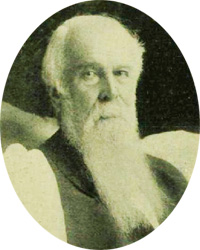

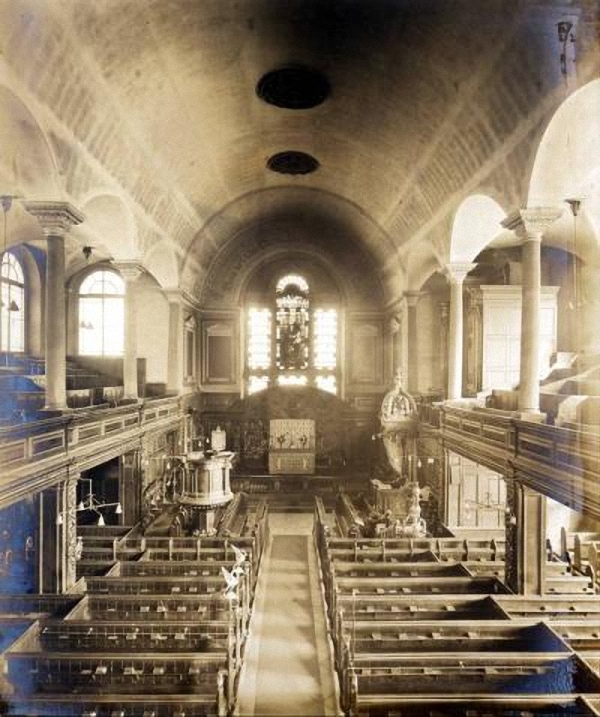

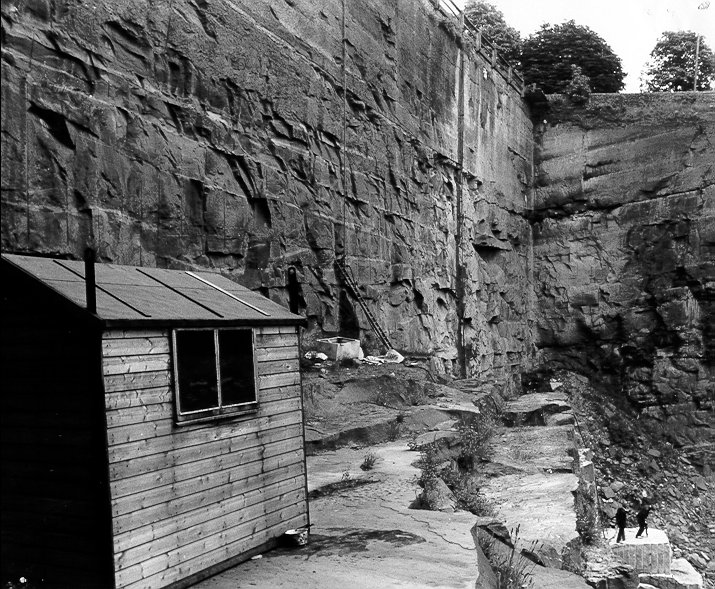


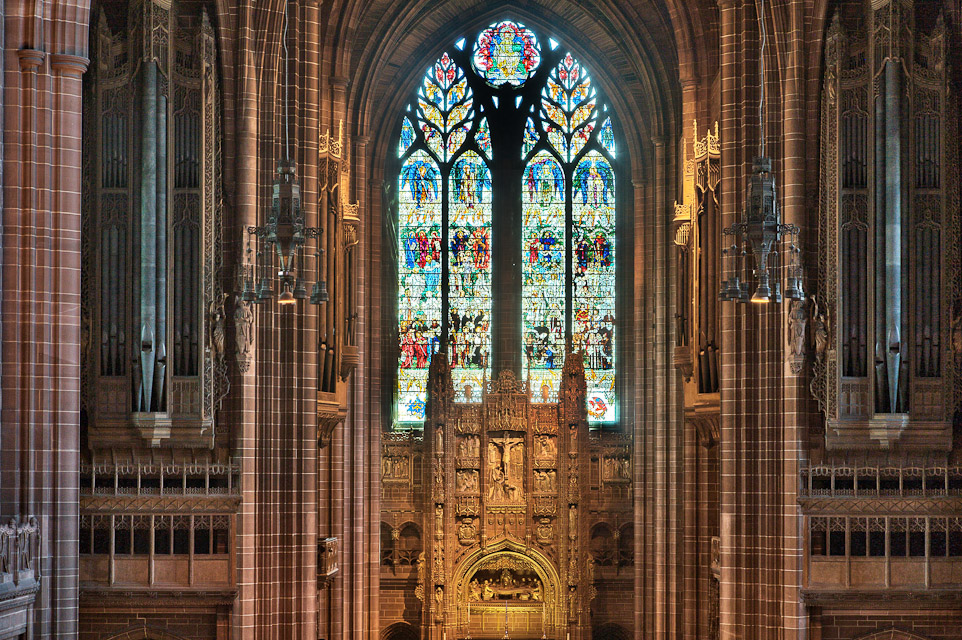

 Reply With Quote
Reply With Quote
Bookmarks